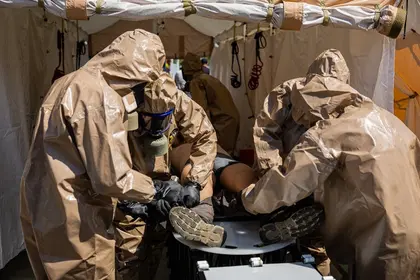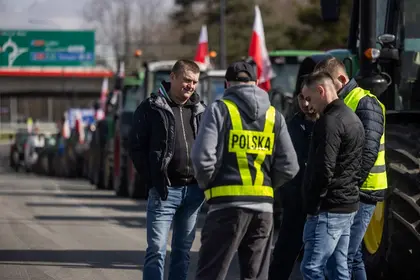Nico Woods, a US Naval Academy graduate, is a former nuclear submarine officer who is qualified to operate and supervise the US Navy’s most advanced nuclear reactors as a nuclear engineer. He spoke to the Kyiv Post to answer some of our readers’ top questions about what the stand-off at the Zaporizhzhia Nuclear Power Plant (NPP) means from a practical standpoint of potential risk.
You are a nuclear engineer: How did that happen?
All US Navy submarines are nuclear-powered, so as an officer I was required to undergo nuclear training to operate and supervise nuclear plant operations. Nuclear submarines are unparalleled in what they can do. They produce their own electricity, water, oxygen, so practically the only reason they need to come back to port is to resupply on food for the crew.
How much time did you spend on nuclear submarines? What was your job?
I spent over three years assigned to submarine duty. Most of that time I was underwater. As an officer, I held multiple jobs, from supervising nuclear plant operations to driving the submarine. The nuclear reactor used is water-pressurized, the same type of design used at the Zaporizhzhia NPP.
What do you make of the situation surrounding the Zaporizhzhia NPP?
It is concerning because, from verified reports, the operators are not given full autonomy over plant operations. Then there are reports of military attacks at the plant that risk the integrity of the reactor cores. A nuclear reactor requires 24/7 supervision to ensure that all operations are normal. Any one reactor can have over 100 parameters which must be within specification to ensure safe and reliable plant operations.

Germany Arrests Two Over Military Base Attack Plot for Russia, Aimed at Undermining Support for Ukraine
How serious is this situation?
If the plant workers are unable to do their job of maintaining the reactors safely and providing reliable electricity, or if the plant undergoes risk of physical destruction from military attacks, there will be a high risk of either damage to the nuclear reactor cores or possible breach of containment.
What is the worst case scenario?
Breach of containment of any of the nuclear reactors would release nuclear radioactivity into the environment. This will not only have an impact on the local area but, if released airborne, the radioactivity could spread to all over Europe. While the reactors are well- protected with lead shielding to protect the plant workers, it does not serve as a missile shield.
If there was a nuclear accident: What would it be most likely ? Mushroom clouds?
Given the inherent characteristics of a water-pressurized reactor with the installed safety features at the plant, the most likely accident would be a release of nuclear radioactivity from a breech in its containment. Given the vast possibilities of how that can occur, it is of utmost importance that every action be taken to prevent it.
It is said that water/electricity might be cut-off to the plant. What does that do?
Nuclear reactors produce a lot of heat when they are operating, so much so that they require electricity to run cooling pumps to ensure that the water is constantly removing heat. Should there be a loss of electricity that results in the loss of power to the reactor pumps, then the core is at risk of overheating. If the core overheats, the fuel cells can melt and you’ll have a release of radioactive elements in the nuclear reactor’s primary cooling system. While still contained inside the plant, there is now one less safety mechanism stopping the release of radioactivity into the environment.
How big are these reactors?
This is the largest nuclear power plant in Europe. These reactors are the size of a small building and the containment facility is as big as an office building.
How long does it take a reactor to melt down if it stops cooling?
Depending on the plant parameters at the time of loss of cooling, it could be minutes to hours.
Is there anything visibly burning that people located in nearby cities would see if the thing melted-down?
There would be no indication to the public if there was damage to the core unless there was a breach in the containment building.
How long would everything remain radioactive?
The radioactive elements produced in a uranium-based nuclear reaction have a half-life (which is the length of time for 50% to decay) of over a billion years. This is why every measure to contain the radioactive elements is of the utmost importance.
You’re now in Kyiv. Knowing what you know, if you lived in Zaporizhzhia, would you leave?
I think it would be wise for local residents to have an evacuation plan if the situation deteriorates so they can leave the area.
What are you doing in Kyiv?
I am running a charity, Ukrainian Freedom Fund (www.theUFF.org), that helps provide humanitarian and non-lethal aid to Ukraine’s military forces.
Any final thoughts?
Tobias Ellwood and Adam Kinzinger, members of the UK and US legislative branches, respectively, have signalled that a release of radioactivity from the Zaporizhzhia NPP would be a breach of NATO’s Article 5, which is that an attack on a member state of the defensive alliance is an attack on all of them. The reasoning here is that the release of radioactive elements will not be contained to Ukraine as it could become airborne or seep into the nearby Dnieper River which feeds into the Black Sea. NATO should address this concern urgently to reduce the current risk at the Zaporizhzhia NPP.
You can also highlight the text and press Ctrl + Enter






Comments (0)